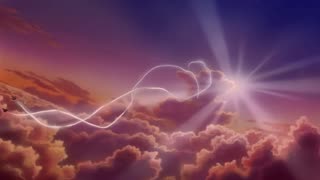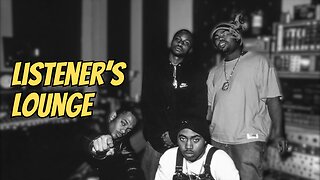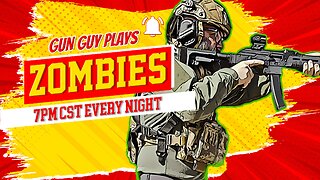Premium Only Content

Green River Cotton Fields Long As I Can See The Light Creedence Clearwater Revival
Green River Album: Green River (1969)
Cotton Fields Album: Willy and the Poor Boys (1969)
Long As I Can See The Light Album: Cosmo's Factory (1970)
by Creedence Clearwater Revival
Green River was written by John Fogerty, who explained in his Storytellers special: "Green River is really about this place where I used to go as a kid on Putah Creek, near Winters, California. I went there with my family every year until I was ten. Lot of happy memories there. I learned how to swim there. There was a rope hanging from the tree. Certainly dragonflies, bullfrogs. There was a little cabin we would stay in owned by a descendant of Buffalo Bill Cody. That's the reference in the song to Cody Jr. ["Up at Cody's camp I spent my days..."]
The actual specific reference, Green River, I got from a soda pop-syrup label. You used to be able to go into a soda fountain, and they had these bottles of flavored syrup. My flavor was called Green River. It was green, lime flavored, and they would empty some out over some ice and pour some of that soda water on it, and you had yourself a Green River."
John Fogerty has said that Green River is his favorite Creedence Clearwater Revival album, in part because it sounds like the '50s albums by the likes of Elvis Presley and Johnny Cash that came out of Sun Records in Memphis.
Asked about his song writing by Mojo magazine, John Fogerty replied: "More common is me fooling around on the guitar coming up with a riff or a lick or even just a tone which sparks some kind of creativity. Your mind gets a vibe, like the lick for 'Green River' - that's what it sounded like, a green river, ha ha. And that was a title I had carried around since I was about eight years old."
Creedence Clearwater Revival included their cover of "Cotton Fields" as the third track on their 1969 album Willy and the Poor Boys. Their version hit No. 1 in Mexico in 1970.
Recorded by Lead Belly in 1940, "Cotton Fields" was introduced into the canon of folk music via its inclusion on the 1954 album release Odetta & Larry which comprised performances by Odetta at the Tin Angel nightclub in San Francisco with instrumental and vocal accompaniment by Lawrence Mohr; this version was entitled "Old Cotton Fields at Home". The song's profile was boosted via its recording by Harry Belafonte first on his 1958 album Belafonte Sings the Blues, with a live version appearing on the 1959 concert album Belafonte at Carnegie Hall. Belafonte had learned "Cotton Fields" from Odetta and been singing it in concert as early as 1955. A #13 hit in 1961 for The Highwaymen, "Cotton Fields" served as an album track for a number of C&W and folk-rock acts including Ferlin Husky (The Heart and Soul of Ferlin Husky 1963), The Delltones (Come A Little Bit Closer 1963), Buck Owens (On the Bandstand 1963), the New Christy Minstrels (Chim-Chim-Cheree 1965) and the Seekers (Roving With The Seekers 1964). Odetta also made a new studio recording of the song for her 1963 album One Grain of Sand. The Springfields included "Cotton Fields" on a 1962 EP release; this version is featured on the CD On an Island of Dreams: The Best of the Springfields. "Cotton Fields" was also recorded by Unit 4+2 for their Concrete and Clay album (1965). A rendering in French, "L'enfant do", was recorded in 1962 by Hugues Aufray and Petula Clark.
The original lyrics, written by Lead Belly, state that the fields are "down in Louisiana, just ten miles from Texarkana". Later versions (e.g., Creedence Clearwater Revival's) say the fields are "down in Louisiana, just about a mile from Texarkana". While the twin cities of Texarkana (in Texas and in Arkansas) are about 30 miles north of the Arkansas–Louisiana border, the larger Texarkana metropolitan area directly abuts the Arkansas-Louisiana state line.
Covers of Cotton Fields include...
Bill Monroe 1962, Decca Records DL4266
Jimmy Page, at age 13, performed "Cotton Fields" live on television on April 6, 1957, with a skiffle band from Epsom County Pound Lane Primary School.
In 1962, The Highwaymen (folk band) recorded their version, which peaked at #13 on the US Hot 100 and #3 on the Easy Listening chart.
Teddy Randazzo And The Dazzlers, on his 1962 Album "Teddy Randazzo Twists", ABC-Paramount 45-10350 / 10350 and european single Karusell, KFF 409
Johnny Cash on his 1962 album The Sound of Johnny Cash
Ace Cannon recorded a popular version of the song in 1963.
The Angels in 1963 that went to No. 119 in the US
Johnny Mann Singers on the 1963 album Golden Folk Song Hits – Liberty LST-7253
Esther & Abi Ofarim performed "Cotton Fields" live on television in 1963 and 1969. They recorded a German version, "Wenn ich bei Dir sein kann", in 1964, which reached the Top 10 in West Berlin.
Eddy Arnold (with the Needmore Creek Singers) on the 1964 album "Folk Song Book"
Rose Marie on episode 102 of The Dick van Dyke Show "The Alan Brady Show Goes to Jail" (1964)
The Carter Sisters on their album The Best of The Carter Family (1966)
Webb Pierce on the 1966 Decca album Webb's Choice
Harry Dean Stanton, in one scene of the 1967 film Cool Hand Luke, plays a sped-up version
Udo Jürgens a 1968 single
Charley Pride on his album Charley Pride in Person released January 1969.
Elvis Presley in the 1970 movie Elvis: That's the Way It Is
Candies on their album Namida no Kisetsu in English as track 10 in 1974.
Alamgir in the 1980s, Pakistani pop star
Joe Dassin on 1989 Sony Music compilation Vol.2.
Donna Douglas on her 1989 album Back on the Mountain
The Pogues on their 1989 album Peace and Love (while this version references the original in its lyrics, the song itself is not a cover per se)
Teresa Brewer on The Muppet Show
Tesla released a cover version as the B-side to the single What You Give, released in 1991
Red Grammer released a cover version on his album "Red Grammer's Favorite Sing Along Songs" in 1993.
Kitten recorded a version of the song on their 2007 album Yodeling Cowgirl
Flatfoot 56 (a Celtic Oi! band) covered it on their album Toil, released in 2012
Elton John on the Cotton Fields: 16 Legendary Covers From 1969/70 album, released in 2004
The Springfields
Ramón Ayala
James Last on the 1971 album Happyning and reissued on the 4-CD set Beachparty released in 2015.
"Long As I Can See the Light" is a song from the album Cosmo's Factory. Released as the flip side of the single "Lookin' Out My Back Door" in 1970, it reached number 57 on the Cash Box singles chart in the US, number 20 in the UK (in the UK, "Long As I Can See the Light" was on the A-side, and "Lookin' Out My Back Door" on the flip), and number one in Norway.
Cash Box compared it to "Lookin' Out My Back Door", calling "Long as I Can See the Light" "a slower paced ballad from the blues school. More subtle, but a good bet to overtake the “Lookin’” side." Billboard called it a "funky blues number."
The two songs were also released as a double-sided single and peaked at number two in the US.
"Long As I Can See the Light" appears on most Creedence Clearwater Revival compilation albums, notably The Best of Creedence Clearwater Revival and Chronicle: The 20 Greatest Hits. It became a concert staple for singer John Fogerty as a solo artist.
Fogerty biographer Thomas M. Kitts describes the song as depicting a "world-weary figure", perhaps Jeremiah, who "undertakes an uncertain journey." The singer is confident as long as he "can see the light." Kitts points out that the word 'light' has two meanings in the song: a spiritual meaning, such as in "The Lord is my light" from Psalm 27, and "the secular light of love". He describes the music as having a "hymnal, church-like feel."
Fogerty expressed surprise at having come up with a candle as a metaphor for a beacon guiding the singer home. He stated that the song is "about the loner in me. Wanting to feel understood, needing those at home to shine a light so that I can make my way back."
"If you tour a lot, it's one of those songs that just makes you miss home so badly," remarked Slipknot front-man Corey Taylor. "A really sombre piece."
The drum beat was sampled by Moby for "The Sky Is Broken" on his 1999 album Play.
-
 10:12
10:12
Psychological operations
10 days agoWhere Is My Mind Hey Monkey Gone To Heaven Pixies
611 -
 1:33:41
1:33:41
Kim Iversen
11 hours agoMichael Flynn, Steve Bannon and Trump: Sean Stone Reveals The Deep State's Plot To Take Down An American President
111K97 -
 58:39
58:39
Flyover Conservatives
1 day agoPorn & LGBTQ+ Agendas in Schools: What You Can Do - John Amanchukwu; 7 Key Indicators You Can't Ignore - Dr. Kirk Elliott | FOC Show
68.3K8 -
 5:40:43
5:40:43
Drew Hernandez
15 hours agoTRUMP RALLY WI, CNN LIES & MARK CUBAN NUKES KAMALA
87.4K1 -
 1:53:28
1:53:28
Glenn Greenwald
11 hours agoMedia Fabricates Trump’s Call For Liz Cheney’s Execution; Slate Writer Demands Usha Leave JD; Darren Beattie On 2024 & Pakistan | SYSTEM UPDATE #361
120K74 -
 1:12:53
1:12:53
Havoc
12 hours agoListener's Lounge - The Chat Takeover
69.9K2 -
 5:56:05
5:56:05
Tundra Gaming Live
14 hours ago $9.64 earnedOne More Day Of Zombies Then Back To Warthunder
64.5K -
 6:43:15
6:43:15
Right Side Broadcasting Network
2 days agoLIVE: President Trump Delivers Remarks at a Rally in Warren, MI - 11/1/24
311K29 -
 36:53
36:53
Stephen Gardner
10 hours ago🔥Col. Douglas Macgregor: Kamala's inexperience is DANGEROUS | Israel & Ukraine NEED Trump!
66.9K108 -
 4:49:22
4:49:22
Nerdrotic
13 hours ago $59.38 earnedWoke Hollywood Collapse, Agatha Farts in the Wind - Friday Night Tights 326 w/ Baggage Claim, Savvy
116K18